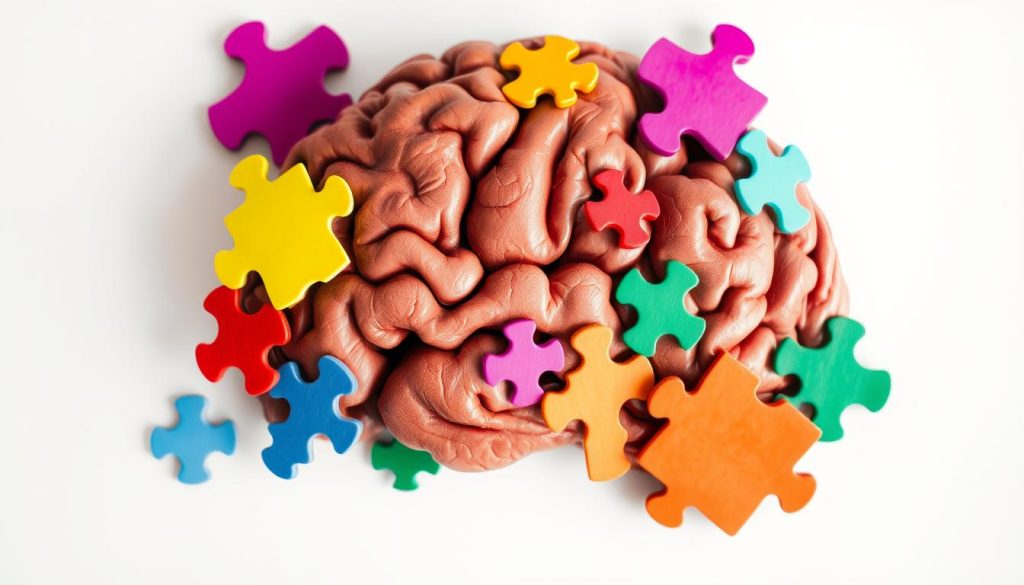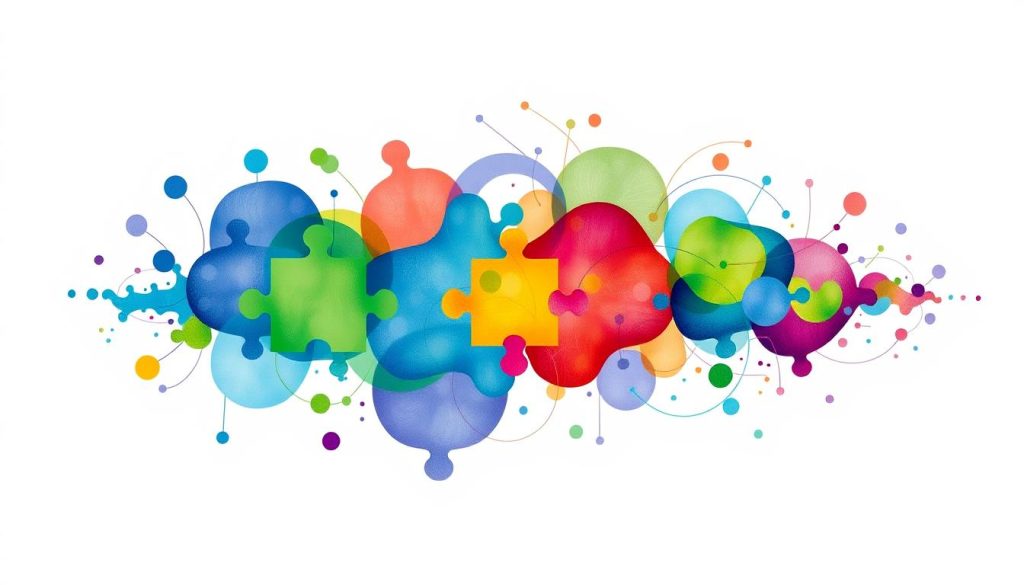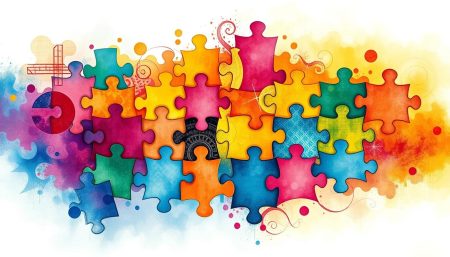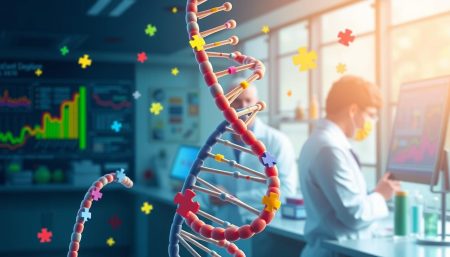Every morning, we learn more about the world of autism spectrum disorders (ASD). What was once a mystery is now a key topic in the U.S. It’s all about autism awareness and changing how we see it. By exploring ASD, we start to understand the special experiences of those affected and work together to grasp understanding autism.
Today, talking about autism is not just for doctors anymore. It’s a part of our everyday conversations. By pushing for support, education, and inclusion, we’re gaining a deeper respect for those with ASD.
What Are Autism Spectrum Disorders (ASD)?
Autism Spectrum Disorders (ASD) are a group of neurodevelopmental conditions. They make social interaction, interests, and behaviors repetitive. These brain differences affect how people interact and communicate.
The Definition of ASD
The Centers for Disease Control and Prevention (CDC) says ASD is a developmental disability. It’s caused by differences in the brain. Knowing the wide range of autism helps us understand the abilities and challenges of those with ASD.
Prevalence of Autism Spectrum Disorders
Studies show about 1 in 54 children have ASD. This number has gone up a lot in the last ten years. It shows we need more research, better diagnostic tools, and support for these families.
Different Types of ASD
The DSM-5 lists different types of autism, like Asperger’s syndrome and PDD-NOS. Each type has its own challenges and strengths. They affect people in different ways.
| Type of ASD | Characteristics | Common Challenges |
|---|---|---|
| Asperger’s Syndrome | High functioning, strong verbal skills | Social interaction |
| PDD-NOS | More severe social and communicative challenges | Flexibility in thought and behavior |
| Autistic Disorder | Significant language delays, social and communication challenges | Repetitive behaviors and interests |
It’s important to know about these forms of autism. This helps us provide the right treatment and support for each person with ASD.
The History and Evolution of Autism Diagnosis
The journey to understand and diagnose autism has been complex and changing. At first, autism was mixed up with schizophrenia. This showed a big misunderstanding of its unique nature as a developmental disability.
To understand how our view of autism has changed, let’s look at key moments in its history:
- 1943: Leo Kanner’s paper first defined “early infantile autism.”
- 1960s: Autism was seen as different from schizophrenia. This was thanks to researchers like Bernard Rimland who showed its biological roots.
- 1980: Autism got its own diagnosis in the DSM-III.
- 1990s: The definition of autism grew. It was recognized as a spectrum of disorders, leading to Autism Spectrum Disorder (ASD).
- 2000s: There was a push for early diagnosis and treatment. This was helped by better screening methods.
- 2013: The DSM-5 combined all autism disorders into one diagnosis. This showed how the criteria for autism have changed.
These changes show how our understanding of autism has grown. They also highlight the changes in how the medical community views autism.
Recent research keeps improving how we diagnose autism. It uses genetic info and neuroscientific insights. This has big implications for managing developmental disabilities. As our understanding grows, we can expect even more precise criteria and tools in the future.
| Decade | Diagnostic Concepts | Impact on Treatment Approaches |
|---|---|---|
| 1940s-1960s | Identification of autism as distinct from schizophrenia, focus on psychoanalytic approaches. | Limited effective treatments, heavy reliance on institutional care. |
| 1970s-1980s | Recognition of biological basis, introduction of DSM-III classifications. | Emergence of behavior therapy, decreased use of institutionalization. |
| 1990s-2000s | Introduction of the spectrum concept, DSM-IV adjustments. | Shift towards early intervention, tailored educational strategies. |
| 2010s-Present | Consolidation under DSM-5, emphasis on genetic and neurodevelopmental research. | Focus on integrated, personalized treatment plans, increased use of technology in interventions. |
This table shows the big changes in how we diagnose autism over time. It highlights how history affects how we manage developmental disabilities today.
Recognizing Early Signs and Symptoms of Autism
Spotting early signs of autism is key for early help and support. Knowing common autism symptoms helps in catching it early. This can greatly improve life for those with Autism Spectrum Disorder (ASD).
Behavioral Indicators of Autism
Behavioral signs are often the first hints of autism. Look for things like sticking too closely to routines, repeating actions like rocking, and intense interests. Each person shows symptoms differently, so it’s important to pay close attention.
- Repetitive behavior patterns
- Intense interests in specific subjects
- Strong preference for predictability and routines
Communication Challenges Related to ASD
Communication issues are big signs that might mean a child needs to be checked for autism. Some kids might talk late, have trouble keeping a conversation going, or struggle with both words and body language.
- Delayed speech milestones
- Difficulties in conversation fluency
- Challenges in using gestures
Social Interaction and Autism
Problems with social interactions can also hint at autism. Kids with ASD might not want to play with others or have trouble with games. They might also find it hard to understand what others feel or think.
- Apparent disinterest in social interactions
- Difficulty reading social cues
- Struggle to grasp shared interests or emotions
Autism Spectrum Disorders Diagnosis Procedures
The journey to a confirmed Autism Spectrum Disorder (ASD) diagnosis involves many steps. These steps are designed to ensure accuracy and a deep understanding of an individual’s condition.
Screening and Evaluation Tools for Autism
ASD screening is key in catching autism early. Tools like the Modified Checklist for Autism in Toddlers (M-CHAT) are used. This first step helps professionals spot kids who need a closer look to meet the diagnostic criteria.
Roles of Professionals in Diagnosis of ASD
Confirming an ASD diagnosis requires a team effort. Psychiatrists, psychologists, and pediatricians work together. They do detailed checks on thinking, behavior, and language to make sure they understand the autism fully.

| Professional | Role in ASD Diagnosis | Tools Used |
|---|---|---|
| Psychiatrists | Conduct behavioral assessments and manage overall mental health. | DSM-5 Criteria, Behavioral Observations |
| Psychologists | Evaluate cognitive functions and perform detailed psychological assessments. | Cognitive Tests, ADOS-2 |
| Pediatricians | Oversee initial screenings and refer to specialists for further evaluation. | M-CHAT, General Developmental Screenings |
Exploring the Causes and Risk Factors of Autism
Understanding autism causes and ASD risk factors is key to better diagnosis and treatment. Studies show a mix of genetic and environmental factors at play. This mix helps us find patterns and create better treatments.
Research has found genes linked to a higher risk of ASD. It shows autism might not come from one gene but from many working together with the environment.
- Family history of ASD raises the chance of a new diagnosis, showing strong genetic ties.
- Exposure to pollutants or chemicals during pregnancy can also increase ASD risk.
- Prenatal health issues, like infections or diet problems, can lead to ASD symptoms.
More genetic research on autism is giving us clues on how genes and environment meet. This knowledge drives more research and policy changes to lower ASD rates and improve lives of those with it.
| Genetic Factor | Environmental Trigger | Risk Increase |
|---|---|---|
| Gene Mutations (e.g., CHD8, SHANK3) | Heavy Metal Exposure | 1.5-2x |
| Copy Number Variants | Prenatal Vitamin Deficiency | Up to 1.7x |
| Hereditary Genetic Syndromes | Maternal Health Issues (e.g., diabetes) | 2-3x |
So, genetic research on autism aims to understand ASD’s roots and improve early detection and prevention. This could lessen the impact of risk factors before they affect development.
Current Trends in Autism Research
The field of autism research is always changing. It’s thanks to both genetic and environmental studies. These studies help us understand Autism Spectrum Disorders (ASD) better.
Genetic Research in Autism
Recent studies have made big strides in autism genetics. They’ve found many genes linked to autism. This knowledge helps us find new treatments and improve early diagnosis.
Environmental Factors Affecting Autism Spectrum Disorders
Research shows how the environment can affect autism. Things like pollutants and chemicals can raise the risk. This research is key for making safer environments for pregnant women and young kids.
Genetic and environmental studies are key to autism science. They give us important information to better manage and understand autism.
Autism Treatment and Intervention Strategies
Managing Autism Spectrum Disorders (ASD) requires a variety of strategies. These include behavioral therapies, educational plans, and medical care. Together, they greatly improve the lives of those with autism.
Behavioral Therapies and Supports
Applied Behavior Analysis (ABA) is a key therapy for autism. It helps improve social, communication, and learning skills. Each person’s needs are met with personalized plans, leading to growth and independence.
Educational Approaches for Children with Autism
Autism education programs are vital. They include Individual Education Programs (IEPs) for a structured learning environment. These programs help children with ASD learn and grow in ways that fit their needs.
Medication and Management of Symptoms
Medicine can help manage symptoms like anxiety and hyperactivity in autism. But, it’s important to use it carefully. Healthcare providers tailor medication to help each person function better and benefit from other therapies.
| Intervention | Benefits | Examples |
|---|---|---|
| Behavioral Therapies | Improves social skills, reduces problem behaviors, enhances learning opportunities | ABA, Pivotal Response Treatment |
| Educational Programs | Supports cognitive development, promotes inclusivity, tailored learning paths | IEPs, inclusive classrooms |
| Medication Management | Alleviates co-occurring symptoms, assists in behavior and emotional regulation | Antidepressants, stimulants |
The Role of Family and Caregivers in Supporting Individuals with Autism
Family advocacy and caregiver involvement are key in improving the lives of those with autism. Families and caregivers play a vital role. They offer love, support, and understanding through the challenges of autism.
Caregivers do more than just help at home. They also support in schools, therapy sessions, and social events. By being active advocates, they help individuals get the help they need and respect they deserve. This support helps them grow and develop positively.
Knowing how to support someone with autism can improve communication and interactions. This leads to a better quality of life. Here’s a table showing how families and caregivers make a difference at different stages and places:
| Stage/Sphere | Role of Family/Caregiver | Impact on Individual with Autism |
|---|---|---|
| Early Childhood | Introducing early intervention programs | Enhances learning abilities and adapts behavior positively |
| School Age | Collaboration with educators and therapists | Promotes tailored educational strategies and social integration |
| Adulthood | Support in vocational training and independent living | Encourages employment opportunities and self-reliance |
Family advocacy and caregiver involvement are more than just support. They are about fighting for the rights and needs of those with autism. This fight is essential for breaking down barriers and ensuring everyone is included and treated fairly.
The journey of supporting someone with autism is a team effort. It greatly benefits from the dedication of caring and informed caregivers and family members who never give up advocating.
Understanding and Destigmatizing Autism Spectrum Disorders
In recent years, we’ve made big steps in making autism less stigmatized. But, old misconceptions are hard to shake off. It’s important to keep teaching and advocating for acceptance. This helps change how society views autistic people and ensures they get the respect they deserve.
Challenging Misconceptions About Autism
Many people think autistic individuals don’t feel emotions deeply or can’t empathize. This belief creates big social and work barriers. Teaching and sharing the truth helps fight these myths. It shows that people with autism have deep feelings and smart minds.
Autism Advocacy and Acceptance Movements
Autism advocacy and acceptance groups have been key in celebrating neurodiversity. They highlight the special talents and skills of autistic people. By valuing these differences, we can create a world where autistic individuals can succeed in all areas of life.
Educational Systems and Autism: Inclusion vs. Special Education
The debate between autism inclusive education and special schooling focuses on what’s best for kids with Autism Spectrum Disorder (ASD). Both sides have their strengths and tackle unique challenges for this diverse group.
Supporters of autism inclusive education say putting kids with ASD in regular classrooms helps them socialize. It also prepares them for the world outside school. They believe it makes everyone more understanding and empathetic.
Special schooling, on the other hand, is made for ASD students. It offers smaller classes, teacher training, and a calm place to learn. This helps students avoid feeling overwhelmed.
- Benefits of Autism Inclusive Education:
- Promotes social skills through regular interaction
- Encourages a society of inclusivity and acceptance
- Enables access to general education curricula
- Advantages of Special Schooling:
- Personalized educational approaches
- Less distracting environments conducive to learning
- Specialized resources and therapies
Choosing between inclusive education and special schooling depends on the child’s needs and what’s available locally. Some kids do well in regular schools, while others need the focus of special schools.
In the end, both autism inclusive education and special schooling aim to help ASD students succeed. The right choice depends on the child’s unique situation and what they need to thrive.
Navigating Autism Resources and Support Networks
Finding the right support for autism can change lives. Good support networks share successes and challenges. They also offer direct help through education and therapy.
Local and Online Autism Communities
Autism communities exist both online and locally. They offer emotional support and practical help. Workshops and events help people connect, no matter where they live.
- Local Support Meetups: Regular meetups help families and individuals connect. They share strategies and find community services.
- Online Forums and Social Media: These platforms connect people worldwide. They offer advice and support any time.
Finding Reliable Information and Services
Finding good autism services is key. Each stage of life with autism needs special help. From early programs to adult services, each is tailored to individual needs.
| Service Category | Description | Impact |
|---|---|---|
| Educational Services | Structured educational programs designed to cater to the unique learning needs of individuals with ASD. | Enhances learning outcomes and social skills development. |
| Therapeutic Services | Includes speech, occupational, and behavior therapies tailored to individual challenges. | Improves daily living skills and overall functioning. |
| Employment Assistance | Programs aimed to integrate adults with ASD into the workforce through job training and placement services. | Increases independence and financial stability. |
Building inclusive environments is vital. Strong support networks and services are key. They help people with autism live fuller lives.
A Glimpse into Daily Life with Autism Spectrum Disorders
Understanding daily life autism challenges is key to creating better support for those with ASD. This knowledge helps tailor approaches that boost independence and manage daily hurdles effectively. For more information, visit this link.
Promoting Independence and Quality of Life
Promoting independence is vital for those with autism to improve their quality of life. Structured routines and clear expectations are essential. They help reduce anxiety and boost confidence, making daily activities easier.
Teaching essential life skills like time management and self-care routines is important. These skills help individuals with autism live more independently. They also reduce the need for constant support.

Strategies for Everyday Challenges
Families and caregivers need strategies to manage sensory sensitivities and communication barriers in ASD. Using visual aids and creating sensory-friendly environments can help. Establishing routines also reduces daily stressors.
Adaptive tools like sound-canceling headphones can help manage sensory overload. These tools make daily life more comfortable for those with autism.
| Challenge | Strategy | Benefits |
|---|---|---|
| Communication Difficulties | Use of visual aids and simplifying language | Enhances understanding and self-expression |
| Sensory Sensitivities | Environmental adjustments, sensory tools | Reduces anxiety and disruptive behaviors |
| Behavioral Issues | Consistent routine, behavior reinforcement | Improves behavior management, promotes calmness |
By addressing daily challenges, we can improve the lives of those with autism and those around them. Learning independence and coping mechanisms can lead to significant progress and fulfillment.
How Society Can Foster a More Inclusive Environment for the Autism Community
Creating a society that values and includes people with Autism Spectrum Disorders (ASD) is key. We need to understand and appreciate their unique views. This means working together in education, jobs, healthcare, and social services.
We must challenge old ways and push for changes that welcome diversity. This includes making policies that support different ways of seeing and interacting with the world.
Increasing awareness about neurodiversity is vital. We should share success stories and offer workshops to educate people. Also, making workplaces more welcoming for those with ASD is important.
Employers can learn a lot about autism. They can hire in a way that values diversity. And they can make their workplaces more friendly for different needs.
Getting the community involved is also essential. We need programs and events that include everyone. Support networks for families are also important.
At the core, we must recognize and respect each person’s abilities. When we do, they can make valuable contributions to society. By embracing diversity and inclusion, we can make a place where everyone feels accepted and empowered.
FAQ
Q: What are Autism Spectrum Disorders (ASD)?
A: Autism Spectrum Disorders (ASD) are complex developmental disabilities. They affect how people interact and communicate. These differences in brain development lead to social and behavioral challenges.
Q: How common are Autism Spectrum Disorders?
A: About 1 in 54 children have ASD, says the CDC. It affects all racial and socioeconomic groups. This shows ASD is widespread.
Q: What different types of ASD are there?
A: The DSM-5 groups ASD into different types. This includes Asperger’s syndrome and PDD-NOS. These categories help in understanding and treating ASD.
Q: How has autism diagnosis evolved over time?
A: Autism diagnosis has changed a lot. It used to be linked to schizophrenia. Now, the DSM-5 defines it as a spectrum with various symptoms and severities.
Q: What are the early signs and symptoms of autism?
A: Early signs include repetitive behaviors and intense interests. Delayed speech and trouble with conversations are also signs. Social challenges, like not wanting to play with peers, are common too.
Q: How is ASD diagnosed?
A: Diagnosing ASD involves two steps. First, a screening with tools like the M-CHAT. Then, a detailed evaluation by a team of experts.
Q: What are currently considered causes and risk factors for ASD?
A: The exact causes of ASD are not known. But, it’s thought to be a mix of genetics and environment. Research is ongoing to understand ASD better.
Q: What are the latest developments in autism research?
A: Research now focuses on genes and environmental factors. Genome studies have found genes linked to ASD. Studies also look at how prenatal exposure might increase risk.
Q: What treatment and intervention strategies exist for autism?
A: Treatments include behavioral therapies like ABA and educational plans. Medications help with symptoms like anxiety. Each person’s treatment is tailored to their needs.
Q: How can families support a loved one with autism?
A: Families are key in supporting loved ones with autism. They advocate for resources and create supportive homes. This helps in promoting independence and opportunities.
Q: How do educational systems accommodate students with ASD?
A: Schools offer inclusion in regular classrooms or special settings. The choice depends on the student’s needs. They may get individual support and services.
Q: Where can I find resources and support for autism?
A: You can find support in local communities and online. Networks offer shared experiences. Services range from therapy to education and vocational programs.
Q: What does daily life look like for someone with ASD?
A: Daily life for someone with ASD involves routines and managing sensory sensitivities. They also need ongoing communication support. This helps improve their quality of life and independence.
Q: What actions can society take to be more inclusive of the autism community?
A: Society can be more inclusive by making policy changes. Changing public views to accept neurodiversity is also important. Creating inclusive spaces helps individuals with ASD fully participate in life.
Q: What is the role of advocacy in autism awareness?
A: Advocacy is key in autism awareness. It challenges misconceptions and promotes acceptance. It fights for the rights and inclusion of individuals with ASD in society.


















